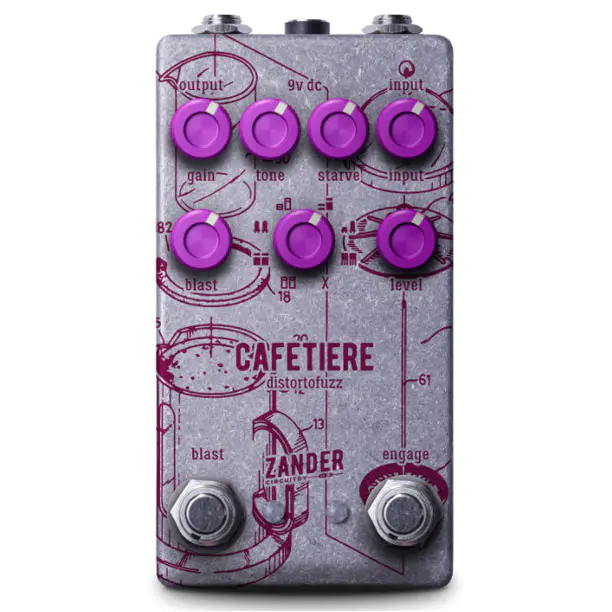
UK’s Zander Circuitry is one of the few truly boutique builders who is churning out pedals that can compete in advanced functionality with the more established builders like JHS or Walrus Audio, and the Cafetiere Distrofuzz V4 is here to prove it: it’s an 8 mode, analog fuzz/distortion pedal with tone and starve knobs and an extra boost footswitch with separate level control. All in a compact box. Impressive.
Born as a variant of the Harmonic Perculator, the Cafetiere has evolved in this new version into something much more than what it used to be: it’s now a Perculator evolution that greatly expands on the original circuit’s signature character.
It does that mostly through the 8 modes (vs 6 of V2) that can be selected through the central rotary switch, which give the player a choise between eight clipping types:
• Germanium: Smooth, sweet, and classically ‘amp-like’.
• Silicon: Louder, brighter, and a little bit brittle.
• LED: Louder again, with less saturation and more punch.
• Asymmetrical germanium: A more aggressive version of germanium.
• Asymmetrical silicon: A more aggressive version of silicon.
• Asymmetrical LED: A more aggressive version of LED.
• Transistor/MOSFET: Similar to silicon, but sweeter and crunchier.
• No diodes: Loads of output and much less gain.
However, the 6 regular knobs also provide plenty of options:
The Input control alters the input capacitance, which effects the low end and overall gain response; Starve drains the circuit of voltage when turned down, which will choke out the decay of the notes and compress the attack; and Tone is a simple low pass filter to tame some of the high end that circuits such as this have quite a bit of.
The Blast knob is the level of the extra boost, activated through the left footswitch, but the Perculator side also features a Level control, which sets the amount of gain feeding the boost circuit, separate from the overall Output one, which comes after the boost.
Check out the video of the Zander Circuitry Cafetiere V4, we added it to our article about the best Harmonic Percolator clones and evolutions.
Zander Circuitry Cafetiere V4, Builder’s Notes
Is it a distortion? Is it a fuzz? Who knows, but what we do know is that it’s possibly one of the strangest beasts in the world of dirt pedals. The Cafetiere is our torn-down, rebuilt and expanded take on the Interfax Harmonic Percolator (HP-1), the spittiest and splattiest ‘fuzz’ pedal that ever existed.
MODES
On top of the self explanatory level and gain controls, the Cafetiere adds a bunch of additional controls that let you fine tune your fuzz sound! The Input control alter the input capacitance, which effects the low end and overall gain response; Starve drains the circuit of voltage when turned down, which will choke out the decay of the notes and compress the attack; and Tone is a simple low pass filter to tame some of the high end that circuits such as this have quite a bit of.
The Cafetiere also features our signature diode rotary switch, which lets you choose between eight clipping types for added versatility:
• Germanium: Smooth, sweet, and classically ‘amp-like’.
• Silicon: Louder, brighter, and a little bit brittle.
• LED: Louder again, with less saturation and more punch.
• Asymmetrical germanium: A more aggressive version of germanium.
• Asymmetrical silicon: A more aggressive version of silicon.
• Asymmetrical LED: A more aggressive version of LED.
• Transistor/MOSFET: Similar to silicon, but sweeter and crunchier.
• No diodes: Loads of output and much less gain.
• And for those who just can’t choose between low and high gain, the Cafetiere’s Blast footswitch turns the gain all the way up, and activates a second volume control for seamless transitions between low and high-gain sounds.SPECS + CONTROLS
There are seven controls that you’ll use to tame the American Geek:
Gain: Gain control
Tone: Low pass filter
Starve: Circuit voltage reduction
Input: Low end and gain response
Level: Output volume
Blast: Output volume (in Blast mode)
1-8: Clipping diode selector
It also has two footswitches:Engage: Turn it on and off
Blast: Activate Blast mode
The Cafetiere features both momentary and latching switching, which means you can hold down one of the footswitches to temporarily engage an effect and then release it to return to normality.Not to mention:
Top-mounted in/out jacks
Power requirements: 9V DC (center-negative) supply
Current draw: 126 mA
Dimensions:(W)67 mm x (L)122 mm x (H)60 mm






















